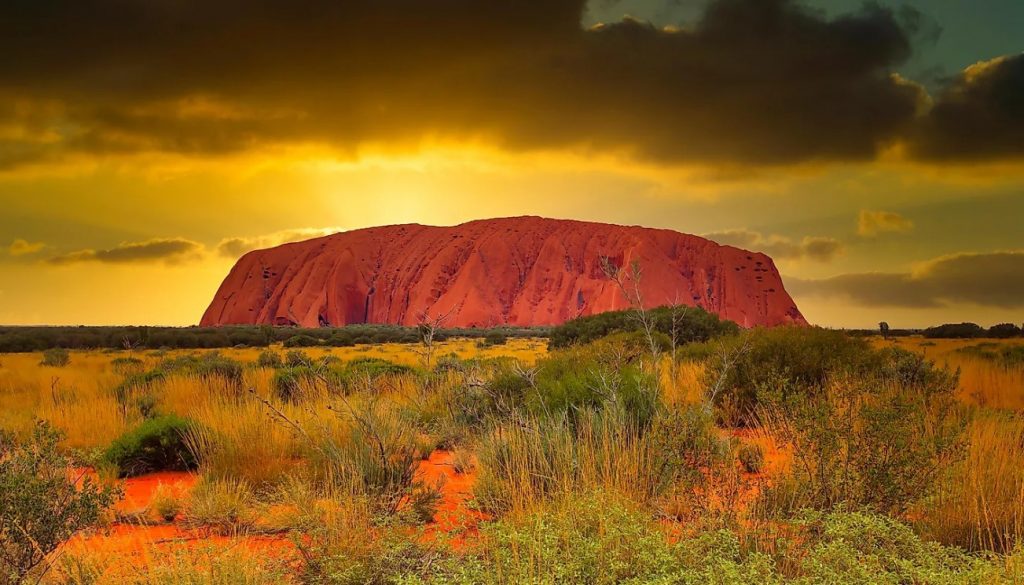
Nestled in the heart of Australia lies the stunning Uluru-Kata Tjuta National Park, a destination that promises a profound connection with nature and culture. This UNESCO World Heritage-listed site is not only a natural wonder but also a place of deep cultural significance for the local Anangu people. Let’s embark on a journey through this extraordinary destination and discover why it’s a must-visit for any traveler to Australia.
Majestic Uluru
At the center of the park stands Uluru, also known as Ayers Rock, one of Australia’s most iconic landmarks. This massive sandstone monolith rises 348 meters above the surrounding plain and has a circumference of about 10 kilometers. The rock’s color changes dramatically throughout the day, glowing red at sunrise and sunset, offering breathtaking photo opportunities.
Must-Do Activities at Uluru:
- Sunrise and Sunset Viewing: Witness the changing colors of Uluru during these magical times of day. Talinguru Nyakunytjaku is a popular viewing platform that offers panoramic views.
- Base Walk: Take the 10.6-kilometer walk around the base of Uluru to experience its grandeur up close. Along the way, you’ll see ancient rock art and learn about the cultural significance of different sites.
- Guided Tours: Join an Anangu guide to gain deeper insights into the spiritual and cultural importance of Uluru. Tours like the Mala Walk are highly recommended.
The Enigmatic Kata Tjuta
Located about 50 kilometers west of Uluru, the Kata Tjuta (also known as the Olgas) is a group of 36 large domed rock formations. Kata Tjuta, which means “many heads” in the local Anangu language, is equally stunning and offers a different perspective on the park’s geology and beauty.
Must-Do Activities at Kata Tjuta:
- Valley of the Winds Walk: This challenging hike takes you through the heart of Kata Tjuta, offering spectacular views and the opportunity to experience the formations up close. The full circuit is 7.4 kilometers.
- Walpa Gorge Walk: A shorter, easier walk that takes you through a lush desert refuge between two of Kata Tjuta’s tallest domes. The walk is 2.6 kilometers and is perfect for those looking for a less strenuous option.
Cultural Significance
Uluru-Kata Tjuta National Park is not just a place of natural beauty; it’s a living cultural landscape. The Anangu people have lived in this region for tens of thousands of years and their connection to the land is deeply spiritual. The park is co-managed by the Anangu and Parks Australia, ensuring that the cultural heritage is preserved and respected.
Cultural Experiences:
- Cultural Centre: Begin your visit here to understand the rich history and traditions of the Anangu people. The center features exhibitions, artwork, and educational displays.
- Bush Tucker Tours: Learn about traditional bush foods and their significance in Anangu culture. These tours offer a hands-on experience of the local flora and fauna.
Practical Information
Getting There: Uluru-Kata Tjuta National Park is located in the Northern Territory. The nearest town is Yulara, which has an airport (Ayers Rock Airport) with flights from major Australian cities. The park is a short drive from Yulara.
Accommodation: Accommodation options range from luxury resorts to campgrounds in Yulara. The Ayers Rock Resort offers a variety of lodging options and amenities.
Best Time to Visit: The best times to visit are during the cooler months from May to September. Summer can be extremely hot, making outdoor activities challenging.
Park Fees: An entry fee is required to enter the park. The fee contributes to the management and preservation of the area.
Conclusion
Uluru-Kata Tjuta National Park is a destination like no other. Its breathtaking landscapes, rich cultural heritage, and unique experiences make it a must-visit for any traveler to Australia. Whether you’re witnessing the mesmerizing color changes of Uluru, hiking through the majestic Kata Tjuta, or immersing yourself in Anangu culture, a visit to this remarkable park promises memories that will last a lifetime. Enjoy your journey to the heart of Australia!